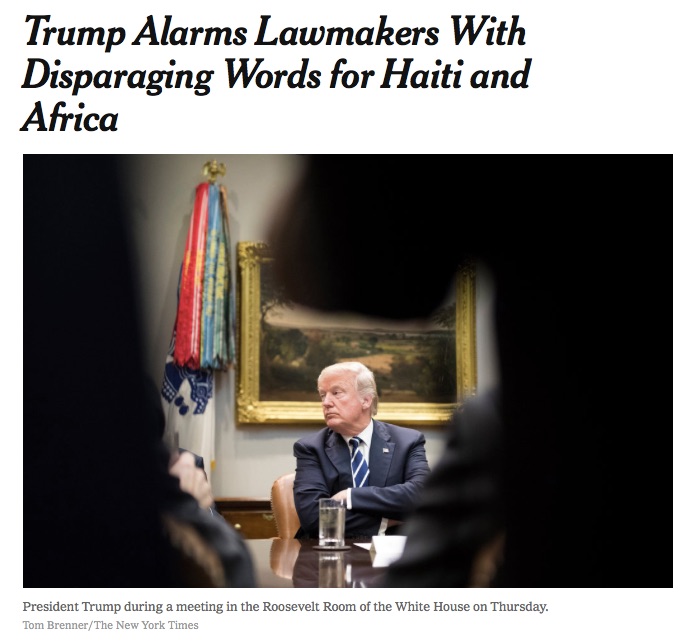As you can’t help but have noticed, on Thursday President Trump made some highly offensive remarks about the country of Haiti, the continent of Africa, and presumably about a couple of countries in central America. He was quoted in the Washington Post as follows:
President Trump grew frustrated with lawmakers Thursday in the Oval Office when they discussed protecting immigrants from Haiti, El Salvador and African countries as part of a bipartisan immigration deal, according to several people briefed on the meeting.
“Why are we having all these people from shithole countries come here?” Trump said, according to these people, referring to countries mentioned by the lawmakers.
Trump then suggested that the United States should instead bring more people from countries such as Norway, whose prime minister he met with Wednesday. The president, according to a White House official, also suggested he would be open to more immigrants from Asian countries because he felt that they help the United States economically.
In addition, the president singled out Haiti, telling lawmakers that immigrants from that country must be left out of any deal, these people said.
“Why do we need more Haitians?” Trump said, according to people familiar with the meeting. “Take them out.”
Let me just start by saying that this blog post (and its follow-up) is an attempt to analyze how the press covers statements like this, not to analyze the character of the president. (If you want to know how I feel – Father James Martin, journalist and Jesuit priest, sums up my feelings quite well.)
There has been considerable debate over what is appropriate and inappropriate for the press to do when the president or a member of his cabinet uses offensive language – especially to express an offensive idea or point of view. Marty Baron, executive editor of The Washington Post, told The Washingtonian:
“When the president says it, we’ll use it verbatim…. That’s our policy. We discussed it, quickly, but there was no debate.”
CNN used the full vulgarity on their chyron Thursday, in a way the network has not generally done:
On Thursday as the news was breaking, Fox News did not use the vulgarity itself on their homepage, but on the actual story used “s—hole” in the headline. For the record, Fox News also reported at the time that they had independently confirmed the president’s statements.
The New York Times declined to use the word in the headline, but did in their story:
 NPR initially did not use the word, referring instead to it as a “vulgarity,” but as the story progressed, the public radio network decided to use the word sparingly — approximately once an hour. MSNBC’s use of the term varied depending on the host. Some used it repeatedly, while Rachel Maddow used the actual word quite sparingly (as his her usual practice with offensive language on the show).
NPR initially did not use the word, referring instead to it as a “vulgarity,” but as the story progressed, the public radio network decided to use the word sparingly — approximately once an hour. MSNBC’s use of the term varied depending on the host. Some used it repeatedly, while Rachel Maddow used the actual word quite sparingly (as his her usual practice with offensive language on the show).
Journalism think tank The Poynter Institute has a good article giving a more complete look at how various outlets reported the story, as did the New York Times.
The vehemently anti-Trump New York Daily News had perhaps the most creative approach, using an emoji-based cartoon to get their message across.
.@realDonaldTrump takes a dump on the American dream
An early look at Friday's front: https://t.co/1Wj57JecKC pic.twitter.com/MmOW4VUIMx
— New York Daily News (@NYDailyNews) January 12, 2018
Twitter, of course, has been exploding over this topic the last few days, but to me, the most significant post I saw was from the Washington Post’s Karen Attiah global opinion editor:
I hope every media outlet that is going to produce outraged pieces about Trump’s “shithole" comments takes a long and hard look at its coverage of black and brown countries.
— Karen Attiah (@KarenAttiah) January 12, 2018
Coming soon: A brief history of offensive language from the White House.

Pingback: Reporting Offensive Language from the White House – Part II | Living in a Media World